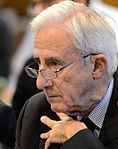1989 Luxembourg general election
Appearance
| |||||||||||||||||||||||||||||||||||||||||
All 60 seats in the Chamber of Deputies 31 seats were needed for a majority | |||||||||||||||||||||||||||||||||||||||||
|---|---|---|---|---|---|---|---|---|---|---|---|---|---|---|---|---|---|---|---|---|---|---|---|---|---|---|---|---|---|---|---|---|---|---|---|---|---|---|---|---|---|
| |||||||||||||||||||||||||||||||||||||||||
| |||||||||||||||||||||||||||||||||||||||||
 |
|---|
General elections were held in Luxembourg on 18 June 1989.[1] The Christian Social People's Party remained the largest party, winning 22 of the 60 seats in the Chamber of Deputies.[2] It continued the coalition government with the Luxembourg Socialist Workers' Party.[3]
Results
| Party | Votes | %[a] | Seats | +/– |
|---|---|---|---|---|
| Christian Social People's Party | 977,521 | 32.4 | 22 | –3 |
| Luxembourg Socialist Workers' Party | 840,094 | 26.2 | 18 | –3 |
| Democratic Party | 498,862 | 17.2 | 11 | –3 |
| Action Committee 5/6ths Pensions for Everyone | 225,262 | 7.9 | 4 | New |
| Communist Party of Luxembourg | 157,608 | 4.4 | 1 | –1 |
| Green List Ecological Initiative | 130,485 | 3.8 | 2 | New |
| Green Alternative Party | 128,622 | 3.7 | 2 | 0 |
| National Movement | 82,316 | 2.3 | 0 | New |
| Ecological List for the North[b] | 16,649 | 1.1 | 0 | New |
| Others | 29,522 | 1.0 | 0 | – |
| Invalid/blank votes | 10,609 | – | – | – |
| Total | 191,777 | 100 | 60 | –4 |
| Registered voters/turnout | 218,940 | 87.6 | – | – |
| Source: Nohlen & Stöver | ||||
a The percentage of votes is not related to the number of votes in the table, as voters could cast more votes in some constituencies than others, and is instead calculated based on the proportion of votes received in each constituency.[4]
b The Ecological List for the North was a joint list of the Green Alternative Party, the Green List Ecological Initiative and some independent candidates which ran in the north constituency.[5]
References



